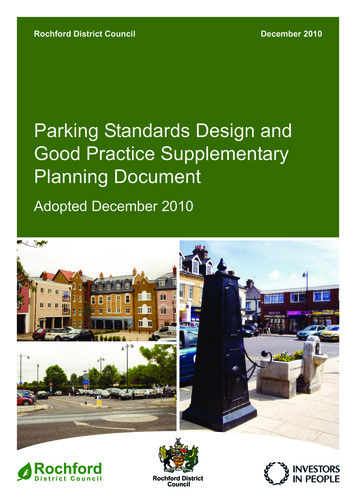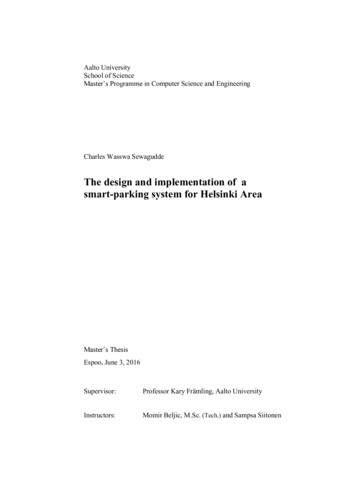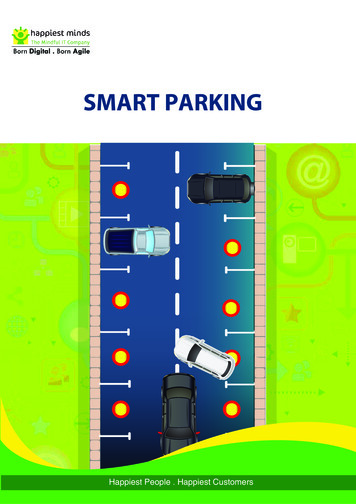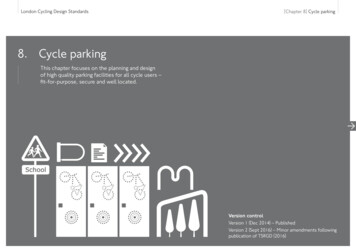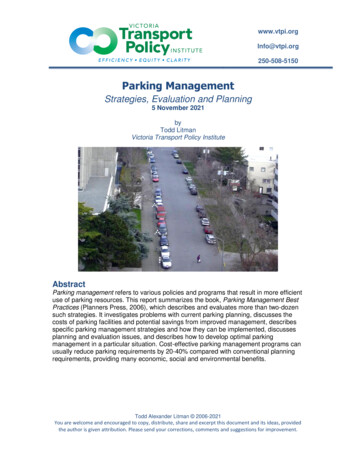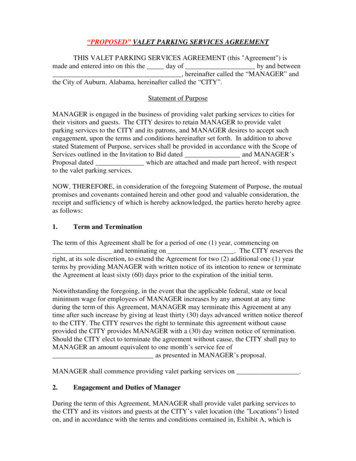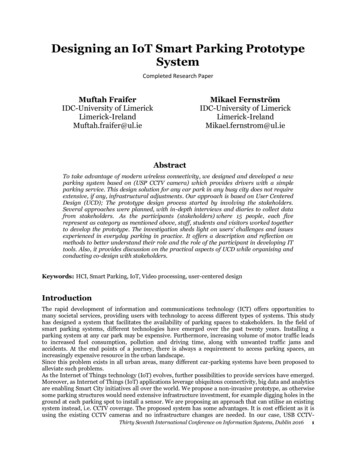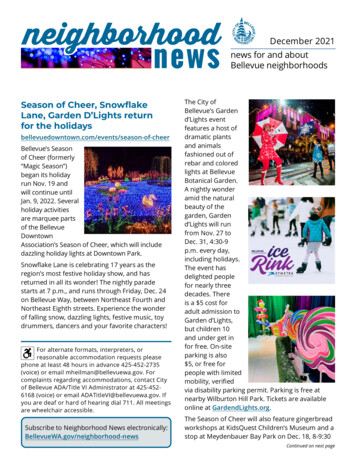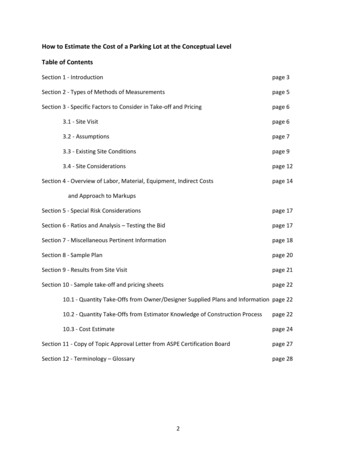
Transcription
Parkingin BostonDecember 2001First EditionCity of BostonMayor Thomas M. MeninoBoston Transportation DepartmentCommissioner Andrea d’Amato
Parkingin BostonPARKING IN BOSTONDecember 2001First EditionCity of BostonMayor Thomas M. MeninoBoston Transportation DepartmentBOSTON TRANSPORTATION DEPARTMENT1Commissioner Andrea d’AmatoACCESS BOSTON 2000-2010
PARKING IN BOSTONCONSULTANT TEAMACKNOWLEDGEMENTSJoe Beggan – Rizzo Associates, Inc.John Crocker – Rizzo Associates, Inc.Alberto Cailao – Rizzo Asscoiates, Inc.Marilyn Palmer – DMJM/HarrisThe Parking in Boston plan has benefited in large part from thecontributions of the many individuals who participated in publicmeetings held as part of the Access Boston 2000-2010 process, submitted written comments, and e-mails. The City of Boston wants tothank all participants who gave generously of their time.This report has been developed from the interest, expertise and contributions of an inter-agency group comprised of:Boston Transportation DepartmentBoston Environment DepartmentBoston Air Pollution Control CommissionBoston Redevelopment AuthorityBoston Police DepartmentCentral Transportation Planning Staff (CTPS)Special thanks to William Kuttner, Central TransportationPlanning Staff (CTPS), for data management servicesPROJECT COORDINATORSADVISORY COMMITTEE ON TRANSPORTATIONVineet Gupta, Director of Policy and Planning,Boston Transportation DepartmentRalph DeNisco, Senior Transportation PlannerBoston Transportation DepartmentAdam Shulman, Transportation PlannerBoston Transportation DepartmentCurtis DavisCo-ChairDiane MoesCo-ChairClaire BarrettMove MassachusettsThomas ButlerSouth BostonBOSTON TRANSPORTATION DEPARTMENTPaul ChanChinatownAndrea d’Amato, CommissionerJames Gillooly, Deputy CommissionerDan Hofmann, Deputy CommissionerThomas Tinlin, Deputy CommissionerJoseph Kelly, Executive Officer Parking BoardBruce Graubart, Assistant Parking ClerkJim Mansfield, Director Community andIntergovernmental ServicesSal LaMattina, Director of OperationsKathleen Moccia, Assistant Director Parking OperationsJohn DeBenedictis, Director of EngineeringAlison Felix, Transportation PlannerPaul Schimek, Transportation PlannerCarolyn DiMambroCARAVANRichard DiminoArtery Business CommitteeJoseph D. FeasterRoxburyDorothea HassWalk BostonSarah HamiltonMASCOWilliam McCabeFormer State PublicSafety CommissionerWilliam ReyeltChair, Boston BicycleAdvisory CommitteeThe Advisory Committee on Transportation was appointed by theMayor of Boston and includes residents and representatives frombusiness, environmental and advocacy groups. It serves as the SteeringCommittee for Access Boston 2000 – 2010.City of BostonNancy Grilk, Environmental Services CabinetToni Pollak, Environment DepartmentBryan Glascock, Air Pollution Control CommissionRebecca Barnes, Boston Redevelopment AuthorityKatherine Kottaridis, Boston Redevelopment AuthorityLynn Berkeley, Boston Redevelopment AuthorityRichard Shaklick, Boston Redevelopment AuthorityRichard Garver, Boston Redevelopment AuthorityACCESS BOSTON 2000-2010www.cityofboston.com/accessboston2BOSTON TRANSPORTATION DEPARTMENT
PARKING IN BOSTONTABLE OF CONTENTSExecutive Summary . iiSummary of Action Plans1.Introduction . 1Economic Growth and ParkingThe Role of Non-Auto AlternativesCompetition for ParkingApproaches in Other U.S. CitiesBTD Roles and ResponsibilitiesAdvocacy for Alternative ModesPublic Process2.Off-Street Parking Inventory . 71997/98 Off-Street Parking Inventory2000-2001 Off-Street Parking Trends by Neighborhood3.Parking Districts . 19Parking Freeze DistrictsACCESS BOSTON 2000-2010Action PlanDistrict-Based Parking GoalsThe Parking Plan is a component of Boston’ citywide transportationplan, Access Boston. Companion reports are listed below.4.Summary ReportPublic and Private SectorOverview of goals and objectives, key findings, recommendationsand implementation and funding strategies.Article 80 Development Review ProcessAction PlanBoston Transportation Fact Book5.Citywide and neighborhood demographic, economic andtransportation facts and trends that affect planning in Boston.Parking Management on Major Corridors . 43Impacts of Double ParkingParking Management RegulationsParking in BostonCorridor Improvement ProgramGuidelines to manage off-street parking and review transportationimpacts of development projects using a district/neighborhoodbased approach and approaches to improve management ofloading zones, metered parking, neighborhood commercialdistricts, and resident permit parking program.Action Plan6.Neighborhood Business Districts . 53Transportation IssuesImpacts of Long-Term ParkingPedestrian Safety Guidelinesfor Residential StreetsOff-Street Parking LotsAction PlanGuidelines to implement operational and design strategies inresidential neighborhoods that enhance pedestrian safety, calmtraffic and improve quality of life.7.Resident Parking . 61The Use of Resident Permit ParkingBoston Bicycle PlanAuto Ownership LevelsPolicies, education programs and facility improvements to createa better environment for bicycling in Boston.Parking Demand on RPP StreetsDemand Reduction ApproachesBoston’s Public Transportationand Regional Connections PlanAction PlanInitiatives to improve existing public transportation service andcreate a priority list of future capital investment and projects.Recommendations for freight movement, commuter corridors,transportation for tourism, intermodal centers, and future capitalinvestment in the highway system that serves Boston.BOSTON TRANSPORTATION DEPARTMENTiDevelopment Review . 358.Funding and Implementation . 69Funding StrategiesImplementation PlaniACCESS BOSTON 2000-2010
PARKING IN BOSTONEXECUTIVE SUMMARYThis report on Parking in Boston is one component of the AccessBoston 2000-2010 citywide transportation plan. Companion reportsaddress pedestrian safety, bicycling, public transportation andregional connections.Auto-related demand can be reduced by encouraging the use oftransit and other alternatives to single occupant vehicles as a meansto travel in and around the city. This approach is reflected in thepolicies and action plans described in this report.The report sets the framework for off-street parking policy byinventorying existing parking supply and identifying district-bydistrict trends for Boston, including the impact of new developmentprojects. The following chapter, on parking districts, describesexisting Air Pollution Control Commission (BAPCC) and zoningregulations that control off-street parking. The Action Plan includesa detailed chart of parking-ratio goals for each of Boston’sneighborhoods and districts. New development review guidelinesare also recommended.GOALSParking management contributes to the quality of life in the city. TheAction Plan outlined in this report seeks to maintain an appropriatelevel and distribution of parking supply in Boston. The location andamount of parking should neither encourage additional auto trips thatoverwhelm our streets nor threaten individual mobility and appropriateauto access. Optimize curb use regulations to promote a balance among theneed for deliveries, short-term parking, and resident parking. Reduce off-street parking in districts that are well served by transit. Manage the location of parking facilities to reduce impacts onneighborhood streets and to achieve an equitable distribution ofbenefits and burdens. Encourage parking turnover in commercial districts to facilitateaccess and commerce and to reduce illegal parking. Coordinate and consolidate regulatory roles and responsibilitiesamong public agenciesACCESS BOSTON 2000-2010On-street parking is primarily addressed by policy that optimizesthe use of curb space among competing users: residents, deliveries,visitors, shoppers and employees. The ongoing corridorimprovement program is discussed. Specific strategies to enhancethe vitality of neighborhood business districts and to make theresident permit parking program more effective are also discussedand recommended.The following key trends inform the recommendations outlined inthis report: Over the last several years:ii Off-street parking supply has increased faster in areas outsidethe downtown than inside the downtown. Employment in the downtown has increased faster than offstreet parking spaces, increasing the competition for public offstreet parking to the detriment of parking availability forshoppers and visitors. Parking charges in lots and garages have increased faster thanon-street metered parking costs, increasing demand for lowerpriced on-street parking. The need for curb space for deliveries continues to increase inthe downtown and in neighborhood business districts. All-day parking in neighborhood business districts is reducingparking availability for shoppers. Auto ownership by Boston residents has grown by 44%, (since1994) increasing demand for residential parking.BOSTON TRANSPORTATION DEPARTMENT
PARKING IN BOSTONSummary of Action Plans Parking Districts Use district-based parking ratio goals to manage growth innew off street parking based on transit access. Increase the availability of short-term parking. Identify the percent goal for reducing the number of off-streetparking spaces per employee . Encourage remote park-and-ride at regional intermodalfacilities.Provide merchants and residents with a basic planning tool toassess transportation conditions. Establish partnerships to fund implementation. Prioritize curb use for loading between 8:00 and 11:00 A.M. inhigh demand areas.Investigate truck-only loading zones.Strengthen loading dock requirements in Article 80development review process.Neighborhood Business Districts Through the formation of a task force, initiate efforts tostrengthen the Boston Proper Parking Freeze. Investigate the construction of new municipal off-streetparking lots. Develop and implement an a system to disseminate real-timeparking information. Use on-street parking for short-term demands. Work with Transportation Management Associations tosupport district-based parking approach.Encourage the increased use of private off-street parking lotsfor long-term parking. Improve pedestrian safety and access. Consolidate loading zones to serve multiple businesses inneighborhood business districts. Continue bicycle racks program. Adjust MBTA bus stop locations to improve service and reduceparking impacts.Development and Project Review Formally adopt the updated Transportation Access PlanAgreement Guidelines. Conduct annual Transportation Access Plan Guideline publicworkshops. Require fees for development review and preparation ofTransportation Access and Construction Management Plans. Create and manage a Geographic Information Systemdatabase to track development projects. Extend permitting process of open air parking lots to includeparking garages. Modify zoning code to require institutional master planTransportation Access Plan Agreements.Resident Parking Program (RPP) Parking Management on Major Corridors Expand the Corridor Improvement Program to additionalstreets for implementation in 2002/3. Increase enforcement and towing capability at meters. Extend multi-ticketing approach to loading zones. Extend meter hours to 8:00 P.M. Investigate deployment of smart meters.BOSTON TRANSPORTATION DEPARTMENTiii iiiCoordinate the implementation of car-sharing programs byprivate vendors.Investigate the joint use of metered spaces through metertechnologies.Strengthen review guidelines for new residential projects.Investigate new parking requirements for condominiumconversion projects.Investigate dividing the Allston/Brighton RPP program.Investigate charging a fee for and/or limiting RPP permitsper household.Investigate a pilot program modeled on Seattle’s “Way to Go,”which pays people not to drive.Develop a Geographic Information Systems database for theRPP Program.ACCESS BOSTON 2000-2010
PARKING IN BOSTONACCESS BOSTON 2000-2010ivBOSTON TRANSPORTATION DEPARTMENT
PARKING IN BOSTON1. INTRODUCTIONThe role of parking as a catalyst for auto travel is an importanteconomic development and quality of life issue in Boston. Proposalsfor new parking lots and garages have raised concerns from residentsand advocacy groups concerned with quality of life andenvironmental issues. Better economic times have brought moreautos to residential neighborhoods as auto ownership levels continueto increase. Future increases in parking challenge the City’s abilityto facilitate equal sharing among different users and modes of travel.Economic Growth and ParkingBoston is an important part of the regional economy: home to onein every seven Massachusetts jobs and one in every thirteen NewEngland jobs. The number of jobs in the city increased by 15% inthe 1990s, reaching 671,000 in 1998, making Boston one of onlythree major cities in the nation with more jobs than residents. Officevacancy rates dropped from 17% in 1991 during the recession to3.3% in 1998. Boston is also a major destination for visitors andtourists. The Greater Boston Convention and Tourism Bureauestimates that 12.9 million people visited Boston in 2000, an increaseof 8.4% from ,000The recent period of economic growth has increased parking demandin Boston. As illustrated in Figure 1, auto ownership in Bostonincreased 36% between 1990 and 2001, adding additional demandfor all-day parking in many neighborhoods. The higher demand forparking by employees and commuters has fueled a general increasein parking rates at many lots and garages, particularly for shortterm parking by shoppers and visitors. Because parking operateson a "first come, first serve" basis, long-term parkers reduce theavailability of parking for short-term parking by shoppers andvisitors. Another result of the high parking demand is an increaseddemand for on-street parking and a higher level of illegal parkingby drivers who are willing to risk getting a parking ticket. The feefor illegal parking is often less than the charge for off-street parkingfor three or more hours. In busy commercial areas, more commercialvehicles are also looking to use on-street loading zones, puttingincreased pressure on limited curb resources and congestion on 00200119191990019City of Boston RegistrationsFigure 1Growth in Auto OwnershipAuto ownership in Boston increased 36% between 1990 and 2001.Nearly all of the growth occurred since 1995. (Source: BTD)The Role of Non-Auto AlternativesThe characteristics of Boston’s parking supply vary by location.The parking supply is constrained in some locations by regulatorylimitations, the availability of transit and the physical limitations ofthe city’s streets. These constraints reduce the total amount of parkingneeded to support the city’s economic centers. By comparison,development in suburban areas will generally add 8 to 10 times theamount of parking that accompanies downtown development.Transit and other modes that reduce auto use must be part of thesolution to improve parking management.BOSTON TRANSPORTATION DEPARTMENT1ACCESS BOSTON 2000-2010
PARKING IN BOSTONDespite high parking costs, many commuters continue to choose todrive into Boston. For some commuters, the high parking costs areoffset by subsidies from their employer. Other commuters absorbthe full parking costs.BTD encourages the use of non-auto modes as a means the bestapproach to reduce traffic parking demands and traffic congestion.The City supports the expansion of the transit system to supporteconomic growth in the downtown and outside. This approachreduces, but does not eliminate the need for new parking. Bettertransit service also provides alternatives for residentialneighborhoods that reduces auto ownership demands. Bicycling isoften also a convenient and fast way get around town. The City’sBicycle Program seeks to improve conditions for cyclists andpromote bicycling.Competition for ParkingAll-day parking in downtown lots can exceed 30 in areas of highparking demand within the downtown.Table 1 provides examples of different types of competing andcomplementary parking and loading demands. The competition forparking is most apparent during the day when commuters competewith other users, usually consuming most of the off-street parkingcapacity before 10:00 a.m. This reduces availability for short-termparkers who arrive after 10:00 a.m. to shop or visit tourist attractions.Residential parking demands occur during the day and night, sincemany residents leave their vehicles on street and use other modes totravel during the day. Resident Permit Parking programs providerelief from external demands such as employee parking, but are noteffective against the growing trend of households with multiple autoownership. Many dense residential neighborhoods have little offstreet parking.“CHEMISTRY OF PARKING”Parking cost and availability affects auto ownership and traveldecisions. Figure 2 describes in schematic form the relationshipbetween the on-street and off-street parking supply, as well as therole played by non-auto modes to relieve parking demands.Figure 2“Chemistry” of Parking2 g demands compliment each other when they occur duringdifferent times of the day, facilitating the joint use of parking spacesby different types of users. In commercial areas in the downtownand in the City’s neighborhoods, the high demand for short-termparking and loading requires an on-street parking managementapproach that encourages turnover – the use of one parking spaceby several vehicles over the course of a day – for both automobilesand commercial vehicles. Striking a balance among the users inboth areas requires prioritizing different types of users at differenttimes of day to reduce conflicts. The City also designates parkingspaces for nighttime use by Increased economic activity at major employment centers will“fuel” an increase in parking demand.Unless the off-street parking supply is increased, the increasedparking demand of an expanding economy will increase parkingcosts for individual motorists.In response to higher costs and reduced parking availability, somemotorists will choose to shift modes and take transit, bicycles orother alternatives to private autos.Some motorists will seek cheaper on-street parking instead ofparking off-street in a lot or garage.ACCESS BOSTON 2000-20102BOSTON TRANSPORTATION DEPARTMENT
PARKING IN BOSTONTable 1 – Examples of Parking DemandsCATEGORYDURATIONDAYTIME PARKING DEMANDSNIGHTTIME PARKING DEMANDSLong-term4 hours or more(Typically 8 hours) Residents Residents Employees Students Commuters Overnight shift workers Students Shoppers Restaurant (valet and non-valet) Visitors Entertainment and cultural venues Hospital outpatient Sports events Students Visitors Building maintenance and service Shoppers Restaurant (valet and non-valet) Visitors Visitors Delivery of goodsIntermediateShort-term2-4 hoursLess than 2 hoursApproaches in Other U.S. CitiesBoston’s off-street parking roles and responsibilities are differentfrom other U.S. cities. Most municipalities exercise some controlover parking supply. Most large U.S. cities either have a parkingauthority or a contract for off-street parking services with an outsidevendor. Depending on the level of control exercised by themunicipality, the rate structure can be used to support different typesof parking, such as short-term shopper and visitor parking. Bostonoperated off-street parking in downtown prior to selling its garagesto offset 1980s budget losses related to Proposition 2½.The San Francisco Department of Traffic and Parking operateseighteen garages with 14,600 parking spaces. Parking is priced at 1.00-2.00 per hour and increases uniformly per hour to themaximum daily rate as compared to 0.75 for 30 minutes of parking(maximum at metered spaces). In some garages, vehicles parkedfor less than 4-hours represent 80-85% of the total vehicles enteringor exiting the facility.Few examples exist of cities with a cap on the number of off-streetspaces. Portland, Oregon capped its downtown spaces in 1975, butincreased the number of spaces during the 1980s. Portland is alsousing parking maximums in its zoning as part of a regional effort toreduce vehicle miles traveled through the reduction in the numberof off-street spaces per capita.Under contract to the City of Portland, the Association for PortlandProgress (APP) operates six short-term garages with 3,400 spaces.The rates in the garages are oriented toward short-term parking.Two garages provide electric recharging for vehicles.BOSTON TRANSPORTATION DEPARTMENT3ACCESS BOSTON 2000-2010
PARKING IN BOSTONBTD Roles and ResponsibilitiesFigure 3BTD’s On-Street Parking Management ResponsibilitiesProcess PParkingarkingTickets andTicketsHold HearingsBTD has both on-street and off-street parking responsibilities.Management of the city’s curb is a core function of BTD. Asillustrated in Figure 3, BTD undertakes a set of interrelated activitiesto manage this limited resource. BTD administers and enforcesparking regulations and installs, fabricates and maintains all streetname, traffic, and parking signs on Boston streets. BTD also regularlycoordinates with other city departments, state agencies and utilitycompanies to manage requests for signage and regulations for newroadway improvements and temporary construction conditions. BTDuses more than 40 different curb regulations to manage on-streetparking by passenger and commercial vehicles. Some keyregulations include:Maintain Signsand MetersDevelop andUpdate CurbsideParkingRegulationsEnforce withParking TicketsTicketsand TTowingowing parking meters and two-hour parking limits to accommodateshort-term parking demands the Resident Permit Parking Program restrictions forresidents only valet parking to promote the more efficient use of limited onstreet parking spaces near restaurants and other attractions designated loading zones for commercial vehicles that activelyload or unload for one hour or lessCurb regulations are also used to prohibit parking, standing orstopping at the curb and to address public safety and trafficmanagement needs. These regulations are intended to ensure thatemergency vehicles can efficiently negotiate city streets, thatpedestrians have safe and accessible streets and sidewalks, and thattraffic can flow efficiently during peak hours and around specialevents and construction activities. BTD also restricts curb parkingto support transit and high occupancy vehicle use by designatingMBTA bus stops, vanpool drop-off/pick-up areas, tour bus stopsand sightseeing trolley stands.BTD currently maintains and operates off-street parking facilitiesthrough its Off-Street Parking Division. These facilities are primarilylocated in neighborhoods outside the downtown. BTD regulates andpermits off-street parking through the following roles: Determine the appropriate amount of parking in newdevelopment projects through the Article 80 zoning reviewprocess. Negotiate parking and supportive Travel Demand Measures(TDM) in the Transportation Access Plan Agreementsrequired for new development projects. Oversee the City’s Parking Freeze through the Boston AirPollution Control Commission (BAPCC).BTD maintains the City’s parking meters.ACCESS BOSTON 2000-20104BOSTON TRANSPORTATION DEPARTMENT
PARKING IN BOSTON Issue Permits for open-air parking lots citywide. Construct, enforce and maintain parking lots in neighborhoodcommercial districts.BTD OFF-STREET PARKING DIVISIONSome of the real property owned by the City is dedicated as municipalparking facilities. BTD has care, custody and control of these sites.The Off-Street Parking Division, through the use of private contractors,maintains these neighborhood lots, which offer parking to the publicwithout charge. BTD’s Off-Street Parking Division also oversees thefollowing:Advocacy for Alternative ModesAccess to transit can reduce auto use, which reduces traffic andparking demands in congested downtown and neighborhood areas.Therefore, the City has adopted a “transit first” approach that looksat public transportation solutions to address access and mobilityneeds of the city’s residents, employees and visitors beforeconsidering automobile alternatives. The City is embracing acomprehensive, multimodal view of transportation that considersthe relationships between all modes and the role of transportationin the creation and support of high quality and attractive urbanenvironments. BTD advocates for the use of transit and bicycling inthe following areas:1.Advocacy for quality transit service through BTD’s role onthe MBTA Advisory Board and the Metropolitan PlanningOrganization.2.Coordination with the BRA to encourage transit-orienteddevelopment.3.Support Transportation Management Associations.4.Support of CARAVAN for Commuters efforts to encouragethe use of alternative modes including carpools and vanpools.5.Development and implementation of the Boston Bicycle Planwith bicycle parking recommendations.6.Development of design plans and other efforts to supportpedestrian access and mobility.BOSTON TRANSPORTATION DEPARTMENT 5Licensing of privately owned fee parking lots, the licensing ofvalet permits and the care, custody and control of City ownedparking lots and facilities.The annual renewal of parking lot licenses through a tri-partyarrangement among BTD, the Inspectional Services Departmentand the Boston Fire Department.The issuance of valet permits on an annual basis and, inaddition to collecting an annual fee, the verification thatapplicants adhere to mandated criteria for permit issuance.ACCESS BOSTON 2000-2010
PARKING IN BOSTONPublic ProcessParking management policies were reviewed and discussed in theAccess Boston 2000-2010 public participation process. On-streetparking was reviewed and discussed during an April 2000 PublicWorkshop and as part of two Discussion Group sessions thatpreceded the Public Workshop. The development of new parkinglots and garages was discussed during a March 2000 PublicWorkshop and two Discussion Group sessions that were held priorto the Public Workshop. These forums were used to identify keyissues and review potential recommendations. Public input wassolicited through a variety of mechanisms that included questionand answer session, breakout discussion at the workshops androundtable discussions. Table 2 summarizes the key parking issuesfrom the public process by topic area.Members of the Mayor’s Advisory Committee on Transportationfacilitated discussions at Public Workshops.Tab le 2 – K ey D iscu ssion P o in ts fro m P u b lic P rocessT O P IC A R E AK E Y D ISC U S S IO N P O IN T SO ff-street P ark ing P arking supply constraints and increasing prices can be used as tools to discourageunnecessary driving and encourage a shift to non -auto m odes. P arking can act as a m agnet to attract auto traffic and create congestion . T he lack of parking and its high costs are seen as a frustrating aspect of urban living inB oston. T he cost of m etered parking has risen relative to the cost of parking at parking lots andgarages and puts add itional pressure on street parking. T he practice of “m eter feeding” by m otorists seeking cheaper long-term parking alternativesto parking lo ts and garages reduces parkin g availability for short-term parking . N ew parking m eter technologies provide oppo rtunities to offer m ore flexible m eter pricingapproaches, to im prove custom er convenience, and to increase m eter reliability. T he lack of adequate off-street loading docks at som e buildings increases dem and at on -streetloading zones, highlighting the need to provide adequate loading dock capacity in newdevelopm ent projects. D ouble parking around loading zones is related to the am ount of loading zone space, th eillegal use of the loading zones and the level of enforcem ent. T he use of on -street loading zones by building contractors and com m ercial vehicles that arenot perform ing delivery functions reduces the availability of these loading zones for goodsdelivery. A ll-day parking on street by com m uters, residents and even m erchants and their em ployeesreduces turnover at the curb and decreases the availability of parking for short -term parkingby custom ers. A m ulti-m odal approach m ust also consider transit, bicycle and pedestrian access into andw ithin a neighborhood com m ercial district. T he approach to addressing resident parking m ust seek to reduce the increasing levels of autoow nership through dem and m anagem ent strategies, such as car-sharing options or restrictionson R P P perm its. T he ratio of perm its to spaces is high . O ff-street parking arrangem ents in existing and new lots and garages could relieve dem and insom e areas w ith lim ited on-street parking opportunities.M etered P ark ingL oading Z on esN eighborho od C om m ercial D istrictsR esid en t P erm it P arkin gACCESS BOSTON 2000-20106BOSTON TRANSPORTATION DEPARTMENT
PARKING IN BOSTON2. OFF-STREET PARKINGINVENTORYA key goal of Access Boston 2000-2010 is better management ofparking to reduce and minimize the impacts of parking related trafficon neighborhood streets. The development of policy to pursue thisgoal begins with an analysis of existing off-street parking supply.This section highlights the inventory of the volume and types ofoff-street parking and identifies district by district trends for
access and commerce and to reduce illegal parking. Coordinate and consolidate regulatory roles and responsibilities among public agencies This report on Parking in Boston is one component of the Access Boston 2000-2010 citywide transportation plan. Companion reports address pedestrian safety, bicycling, public transportation and regional .
